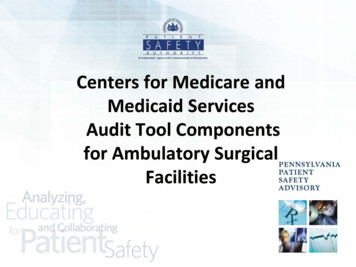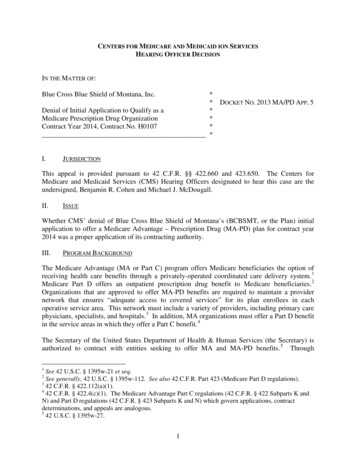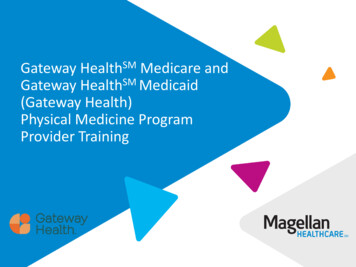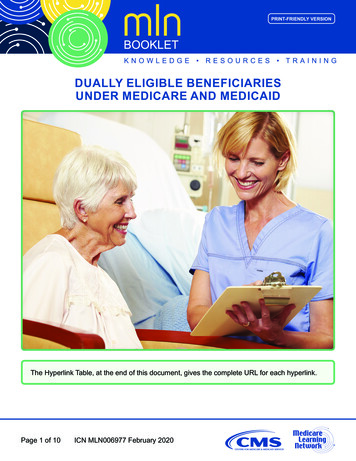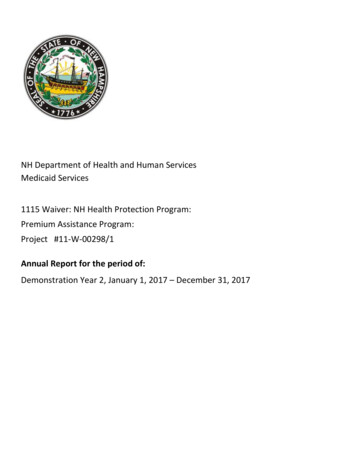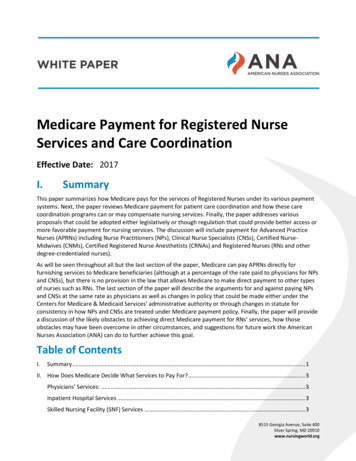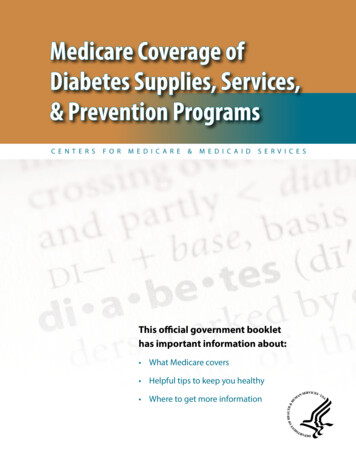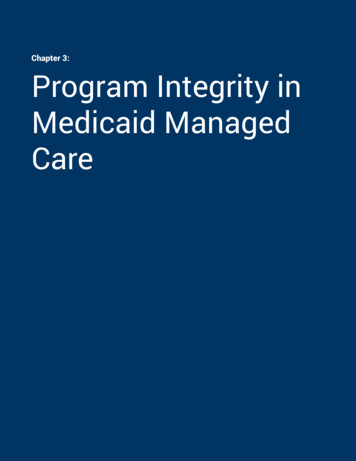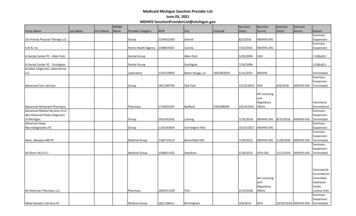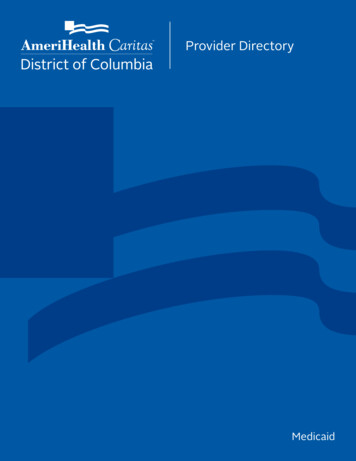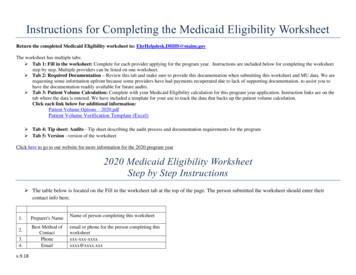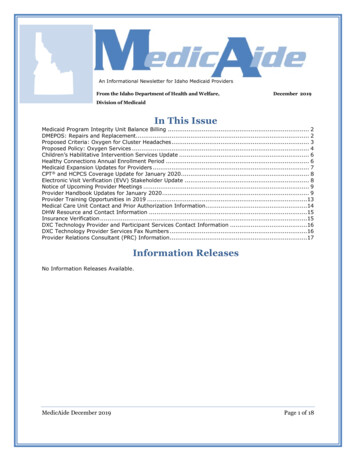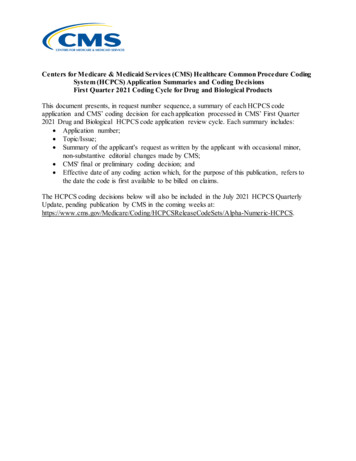
Transcription
Centers for Medicare & Medicaid Services (CMS) Healthcare Common Procedure CodingSystem (HCPCS) Application Summaries and Coding DecisionsFirst Quarter 2021 Coding Cycle for Drug and Biological ProductsThis document presents, in request number sequence, a summary of each HCPCS codeapplication and CMS’ coding decision for each application processed in CMS’ First Quarter2021 Drug and Biological HCPCS code application review cycle. Each summary includes: Application number; Topic/Issue; Summary of the applicant's request as written by the applicant with occasional minor,non-substantive editorial changes made by CMS; CMS' final or preliminary coding decision; and Effective date of any coding action which, for the purpose of this publication, refers tothe date the code is first available to be billed on claims.The HCPCS coding decisions below will also be included in the July 2021 HCPCS QuarterlyUpdate, pending publication by CMS in the coming weeks eCodeSets/Alpha-Numeric-HCPCS.
Request # 20.125Topic/IssueRequest to establish a new Level II HCPCS code to identify Fensolvi (leuprolide acetate) forinjectable suspension for subcutaneous use.Applicant's suggested language: JXXXX “Injection, leuprolide acetate (Fensolvi), 45 mg, forsubcutaneous use.”Applicant’s SummaryFensolvi is a sterile polymeric matrix formulation of leuprolide acetate that is administeredsubcutaneously by a healthcare professional for the treatment of pediatric patients 2 years of ageand older with central precocious puberty. Leuprolide acetate is a synthetic nonapeptide analogof naturally occurring gonadotropin-releasing hormone that possesses greater potency than thenatural hormone.Fensolvi is supplied in a kit that includes 2 prefilled syringes; 1 contains 45 mg of lyophilizedleuprolide acetate powder and the other contains the in-situ polymeric gel delivery system. Thein-situ polymeric gel (non-gelatin-containing) delivery system consists of a biodegradable poly(DL-lactide-co-glycolide) (PLG) polymer formulation dissolved in the biocompatible solvent, Nmethyl-2-pyrrolidone (NMP). Once every 6 months, Fensolvi 45 mg is administeredsubcutaneously, where it forms a solid drug delivery depot.Current HCPCS codes for other leuprolide acetate products are not appropriate for Fensolvi dueto differences in route of administration, formulation, reconstitution process, targeted patientpopulation/therapeutic indication, dosing, absorption, metabolism, needle gauge, needle size,injection volume, and cost.Final DecisionEstablish new Level II HCPCS code J1951 "Injection, leuprolide acetate for depot suspension(Fensolvi), 0.25 mg"CMS has a long-standing convention to assign dose descriptors in the smallest amount that couldbe billed in multiple units to accommodate a variety of doses, making coding more robust,facilitate accurate payment and reporting of exact dose administered.Effective: 07/01/2021Note: Existing modifier "JB" "administered subcutaneously" is available for use to specify routeof administration.Page 2 of 24
Request # 20.146Topic/IssueRequest to establish a new Level II HCPCS code to identify Romidepsin.Applicant’s suggested language: J9XXX “Injection, Romidepsin non-lyophilized (e.g. liquid),per 1MG. Recommended short descriptor: Romidepsin Injection, liquid.”Applicant’s SummaryThe name of the product is Romidepsin Injection, liquid (Romidepsin injection) for intravenoususe. Romidepsin Injection, liquid is a histone deacetylase (HDAC) inhibitor drug. RomidepsinInjection, liquid is a drug used in the treatment of certain types of lymphoma cancer. A newHCPCS code for Romidepsin Injection, non-lyophilized liquid is needed because it is a singlesource drug approved under a unique NDC number, and it needs to be differentiated from theexisting HCPCS code for a multi-sourced Romidepsin drug in lyophilized powder form.Romidepsin Injection, liquid is indicated treatment of cutaneous T-cell lymphoma (CTCL) inadult patients who have received at least one prior systemic therapy. Treatment of peripheral Tcell lymphoma (PTCL) in adult patients who have received at least one prior therapy. Themechanism of the antineoplastic effect of Romidepsin has not been fully characterized.Romidepsin Injection, liquid is supplied in single-dose vials in the following carton packaged 10mg/2 mL (5 mg/mL) and 27.5 mg/5.5 mL (5 mg/mL).Preliminary Decision1. Establish new Level II HCPCS code JXXXX “Injection, romidepsin, non-lyophilized,0.1 mg.”2. Establish new Level II HCPCS code JXXXX “Injection, romidepsin, lyophilized, 0.1 mg.”3. Discontinue existing Level II HCPCS code J9315 "Injection, romidepsin, 1 mg."CMS will take this issue to the next public meeting to allow all interested stakeholders anopportunity to opine on this preliminary decision.Page 3 of 24
Request # 20.200Topic/IssueRequest to establish a new Level II HCPCS code to identify Symphony, an extracellular matrixbioengineered skin substitute derived from ovine forestomach tissue and including hyaluronicacid.Applicant’s suggested language: QXXXX “Symphony, per square centimeter.”Applicant’s SummarySymphony is a bioengineered skin substitute composed of extracellular matrix (ECM) andhyaluronic acid (HA). Symphony contains three layers of ovine-derived ECM, which containsmore than 150 essential ECM proteins, including structural proteins, adhesion proteins, andsignaling proteins—all of which aid the wound healing process. A single layer of HA has beenincluded in the composite design to provide additional healing biology and ensure a moist woundenvironment that is critical to healing. The composite design scaffolds the patient's own cells torebuild dermal tissues in acute and chronic wounds.Preliminary DecisionThis request is being deferred to a subsequent coding cycle because the scope of the requestnecessitates that additional consideration be given before CMS reaches a final decision.Page 4 of 24
Request # 21.001Topic/IssueRequest to establish a new Level II HCPCS code to identify segesterone acetate and ethinylestradiol vaginal system.Applicant’s suggested language: J7XXX “Annovera (segesterone acetate and ethinyl estradiolvaginal system), each.”Applicant’s SummaryAnnovera is a hormonal birth control method that is used for 3 out of 4 weeks every month. Thesame vaginal system is reusable for up to one full year (1 year includes 13 cycles; each cycle is28 days). After the patient inserts Annovera for the first time, the patient will remove it at the endof week 3 and leave it out for 7 days. The patient will then reinsert Annovera at the end ofweek 4 of each 4-week cycle.Preliminary Decision1. Establish new Level II HCPCS code JXXXX “Segesterone acetate and ethinyl estradiol0.15mg, 0.013mg per 24 hours; yearly vaginal system, each”2. Establish new Level II HCPCS code JXXXX “Ethinyl estradiol and etonogestrel 0.015mg,0.12mg per 24 hours; monthly vaginal ring, each”3. Discontinue existing Level II HCPCS code J7303 “Contraceptive supply, hormone containingvaginal ring, each”CMS will take this issue to the next public meeting to allow all interested stakeholders anopportunity to opine on this preliminary decision.Page 5 of 24
Request # 21.001iTopic/IssueReplace HCPCS code J2505 with a new code with a small dose descriptor similar to itsbiosimilar.Suggested language: J code “Injection, pegfilgrastim, 0.5 mg”Applicant’s SummaryCMS has a long-standing convention to assign dose descriptors in the smallest amount that couldbe billed in multiple units to accommodate a variety of doses, making coding more robust,facilitate accurate payment and reporting of exact dose administered. According to the publishedprescribing information, pegfilgrastim dosing could be 1.5 mg to 6 mg depending on thepatient’s weight. In order to facilitate more accurate billing and to simplify the comparison ofpayment amounts for pegfilgrastim and biosimilar products, CMS is considering thediscontinuation of J2505 and replacement with a code that utilizes a descriptor that matches theamount of drug in the pegfilgrastim biosimilar codes.Preliminary DecisionAll of the biosimilars for Neulasta, the brand name for pegfilgrastim, are 0.5 mg. CMS proposesto discontinue HCPCS code J2505 and establish a new code, which will specify 0.5 mg, forconsistency.1. Establish new Level II HCPCS code JXXXX “Injection, pegfilgrastim, excludesbiosimilar, 0.5 mg.”2. Discontinue existing Level II HCPCS code J2505 “Injection, pegfilgrastim, 6 mg.”CMS will take this issue to the next public meeting to allow all interested stakeholders anopportunity to opine on this preliminary decision.Page 6 of 24
Request # 21.002Topic/IssueRequest to establish a new Level II HCPCS code to identify Cygnus Matrix.Applicant’s SummaryCygnus Matrix is a multilayer allograft derived from the amnion and chorion layers of theplacental membrane and is manufactured using a proprietary Integrity Processing Methodology,which helps to maintain the inherent levels of key extracellular matrices, including proteins,carbohydrates, growth factors, and cytokines. Cygnus Matrix retains the structural and functionalcharacteristics of the membrane to provide a barrier or covering, protecting injured tissue fromthe external environment.Final DecisionAfter review of the Food and Drug Administration’s (FDA’s) guidance, it does not appear toCMS that Cygnus Matrix is suitable for registration as a Human Cells, Tissues, and Cellular andTissue-Based Product (HCT/P). CMS refers the applicant to the FDA’s Tissue Reference Group(TRG) to obtain written feedback regarding how the product is appropriately regulated. Afterobtaining the FDA’s written feedback, the applicant is welcome to submit a complete HCPCScode application in a subsequent coding cycle.Information for submitting questions to the TRG is located ssue-tissue-products/tissue-reference-groupPage 7 of 24
Request # 21.003Topic/IssueRequest to establish a new Level II HCPCS code to identify Danyelza (naxitamab-gqgk).Applicant’s suggested language: J9XXX “injection, naxitamab-gqgk, 1mg.”Applicant’s SummaryDanyelza (naxitamab-gqgk) is a glycolipid disialoganglioside (GD2)-binding monoclonalantibody that binds to GD2, which is overexpressed on neuroblastoma cells and other tumors ofneuroectodermal origin, including the central nervous system and peripheral nerves. Danyelzawas approved by the FDA in November 2020, and received rare pediatric disease, orphan drug,and breakthrough therapy designations from the FDA.Final DecisionEstablish new Level II HCPCS code J9348 “Injection, naxitamab-gqgk, 1 mg”Effective: 07/01/2021Page 8 of 24
Request # 21.004Topic/IssueRequest to establish a new Level II HCPCS code to identify Gallium Ga 68 PSMA-11.Applicant’s SummaryGa 68 PSMA-11 is a radiopharmaceutical that is used to localize PSMA-positive metastaticdisease in patients with prostate cancer. Prostate specific membrane antigen (PSMA) isoverexpressed on prostate cancer cells, and can be used to target prostate cancer for the purposeof imaging. After injection of Ga 68 PSMA-11, it is imaged using positron emission tomography(PET) to localize where the radiotracer is, allowing the localization of metastatic disease. Thereare two main uses of Ga 68 PSMA-11 PET in patients with prostate cancer as listed in theprescribing information. The first is in patients at initial staging prior to definitive therapy whoare at risk for prostate cancer. Patients with clinically significant prostate cancer will typically betreated first using either radiation therapy (either external beam or brachytherapy) or radicalprostatectomy. Both of these treatments assume that the prostate cancer is localized. Ga 68PSMA-11 PET allows us to determine if disease is in fact localized to the prostate or has alreadymetastasized outside of the prostate, which would have a significant impact on the treatment ofthe patient. The second use of PSMA PET is in prostate cancer patients with biochemicalrecurrence after definitive therapy. This is typically patients who have undergone either radicalprostatectomy or radiation therapy, and the patient’s prostate specific antigen (PSA) begins torise. When the PSA begins to rise, the patient is known to have recurrence disease, but it is notknown where that disease exists. Ga 68 PSMA-11 PET has a role in localizing metastatic diseasein these men, allowing physicians to choose the appropriate treatment based on where the diseaseis localized.Final DecisionEstablish new Level II HCPCS code A9593 “Gallium ga-68 psma-11, diagnostic, (ucsf), 1millicurie”During this first quarterly HCPCS coding cycle of 2021, CMS reviewed two applications forvery similar radiopharmaceutical products from different applicants. The application for thisproduct was submitted by the University of California San Francisco. To distinguish the code weare establishing for this product from the code we are establishing for the similar product(discussed below), we are adding “(ucsf)” to the descriptor for HCPCS code A9593.Effective: 07/01/2021Page 9 of 24
Request # 21.005Topic/IssueRequest to establish a new Level II HCPCS code to identify Gleolan (aminolevulinic acid HCl).Applicant’s SummaryNX Development Corp is submitting a request for a new HCPCS Code for Gleolan(aminolevulinic acid HCl). Gleolan was approved in June 2017 by the FDA for use as an opticalimaging agent to improve extent of resection in suspected high grade glioma patients. This is asignificant therapeutic distinction for currently, there are no existing HCPCS code that describesusing (Gleolan) to visualize gliomas during brain surgery. Since glioma is a rare diseaseaffecting fewer than 200,000 people annually in the United States, Gleolan received “OrphanDrug” designation to assist surgeons in managing the tumor removal procedure in this criticallyill population. Gleolan is the first fluorescent guided imaging agent approved in patients withsuspected WHO Grades III or IV gliomas and there are no FDA approved comparator products.Final DecisionGleolan is not suitable for coding in Level II HCPCS as it is used exclusively in hospitalinpatient and outpatient settings. For inpatient use, Gleolan would be bundled in hospitalpayment. CMS refers the applicant to CMS' pass-through coding program for consideration ofpass-through coding for use in hospital outpatient settings.Page 10 of 24
Request # 21.006Topic/IssueRequest to establish a new Level II HCPCS code to establish SkinTE.Applicant’s language: QXXXX “Autologous skin product, not otherwise specified.”Applicant’s SummarySkinTE is not a skin substitute, and has none of the characteristics of a skin substitute. It is afully autologous (from the patient for the patient) product used for repair, replacement,reconstruction, or supplementation of skin tissue and integumentary system. SkinTE ismanufactured from a harvested sample of the patient’s full thickness skin and is entirelyautologous, with no additional or supplementary cell or tissue source from another human being(allogeneic) or another animal (xenogeneic), as well as no additive synthetic or prostheticcomponents.Final DecisionAfter review of the FDA’s guidance, it does not appear to CMS that Skin TE is suitable forregistration as a Human Cells, Tissues, and Cellular and Tissue-Based Product (HCT/P). CMSrefers the applicant to the FDA’s Tissue Reference Group (TRG) to obtain written feedbackregarding how the product is appropriately regulated. After obtaining the FDA’s writtenfeedback, the applicant is welcome to submit a complete HCPCS code application in asubsequent coding cycle.Information for submitting questions to the TRG is located ssue-tissue-products/tissue-reference-groupPage 11 of 24
Request # 21.008Topic/IssueRequest to establish a new Level II HCPCS code to establish Kcentra.Applicant’s suggested language: JXXXX “Prothrombin complex concentrate (human), kcentra,per i.u. of factor ix activity.”Applicant’s SummaryKcentra (prothrombin complex concentrate (human)) is a blood coagulation factor replacementproduct. The existing code (C9132) is only recognized by Medicare when furnished in a hospitalsetting. In some instances, Kcentra may be furnished in a nonhospital setting and would bereported under an unspecified code for Medicare patients. In addition, not all payers recognizeC codes and may require that the product be reported under an unspecified code in the hospital aswell as non-hospital settings. A J code is necessary to facilitate consistent reporting of Kcentraacross settings and payers. We note that CMS recently established a J code for a differentanticoagulation reversal product (Andexxa) and the same program operating need identified for aJ code for Andexxa would also apply to Kcentra. Kcentra is indicated for the urgent reversal ofacquired coagulation factor deficiency induced by Vitamin K antagonist (VKA, e.g., warfarin)therapy in adult patients with acute major bleeding or the need for an urgent surgery/invasiveprocedure. The recommended dose is based on the measurement of the International NormalizedRation (INR) prior to treatment and the patient’s body weight. Kcentra is administered throughan intravenous infusion and is supplied in a single use vial.Final DecisionEstablish new Level II HCPCS code J7168 1“Prothrombin complex concentrate (human),kcentra, per i.u. of factor ix activity”Effective: 07/01/2021Discontinue existing HCPCS code C9132 “Prothrombin complex concentrate (human), kcentra,per i.u. of factor ix activity”Effective: 06/30/20211The final, corrected code assignment, for item 21.008, is J7168, as specified in the Final Decision in the 2021HCPCS Application Summary for Quarter 1, 2021 Drugs and Biologics document. Code number J7168replaces code J7169, which was previously published in error.Page 12 of 24
Request # 21.009Topic/IssueRequest to establish a new Level II HCPCS code to identify Margenza.Applicant’s suggested language: “Margetuximab-cmkb injection for intravenous use,250mg/10ml.”Applicant’s SummaryMargenza, a HER2/neu receptor antagonist, is a chimeric Fe-engineered IgG 1 kappamonoclonal antibody used in anticancer treatment. No HCPCS code currently identifies thisunique biological product because no other drugs or biologicals with the same active ingredient(margetuximab-cmkb) exist.The product is indicated, in combination with chemotherapy, for the treatment of adult patientswith metastatic HER2-positive breast cancer who have received two or more prior anti-HER2regimens, at least one of which was for metastatic disease.Upon binding to the extracellular domain of HER2-expressing tumor cells, Margenza inhibitstumor cell proliferation, reduces shedding of the HER2 extracellular domain, and mediatesantibody-dependent cellular cytotoxicity (ADCC). In vitro, the modified Fe region of the productincreases binding to activating Fe receptor FCGR3A (CD16A) and decreases binding toinhibitory Fe receptor FCGR2B (CD32B), which leads to greater in-vitro ADCC and NK cellactivation.The recommended dose is 15 mg/kg, administered every three weeks until disease progression orunacceptable toxicity. The initial dose should be administered over 120 minutes and subsequentdoses over 30 or more minutes every three weeks. Margenza is administered as an intravenousinfusion.Final DecisionEstablish new Level II HCPCS code J9353 “Injection, margetuximab-cmkb, 5 mg”CMS has a long-standing convention to assign dose descriptors in the smallest amount that couldbe billed in multiple units to accommodate a variety of doses, making coding more robust,facilitate accurate payment and reporting of exact dose administered.Effective: 07/01/2021Page 13 of 24
Page 14 of 24
Request # 21.011Topic/IssueRequest to establish a new Level II HCPCS code to identify Oxlumo (lumasiran).Applicant’s suggested language: JXXXX
Replace HCPCS code J2505 with a new code with a small dose descriptor similar to its biosimilar. Suggested language: J code “Injection, pegfilgrastim, 0.5 mg” Applicant’s Summary . CMS has a long-standing convention to
